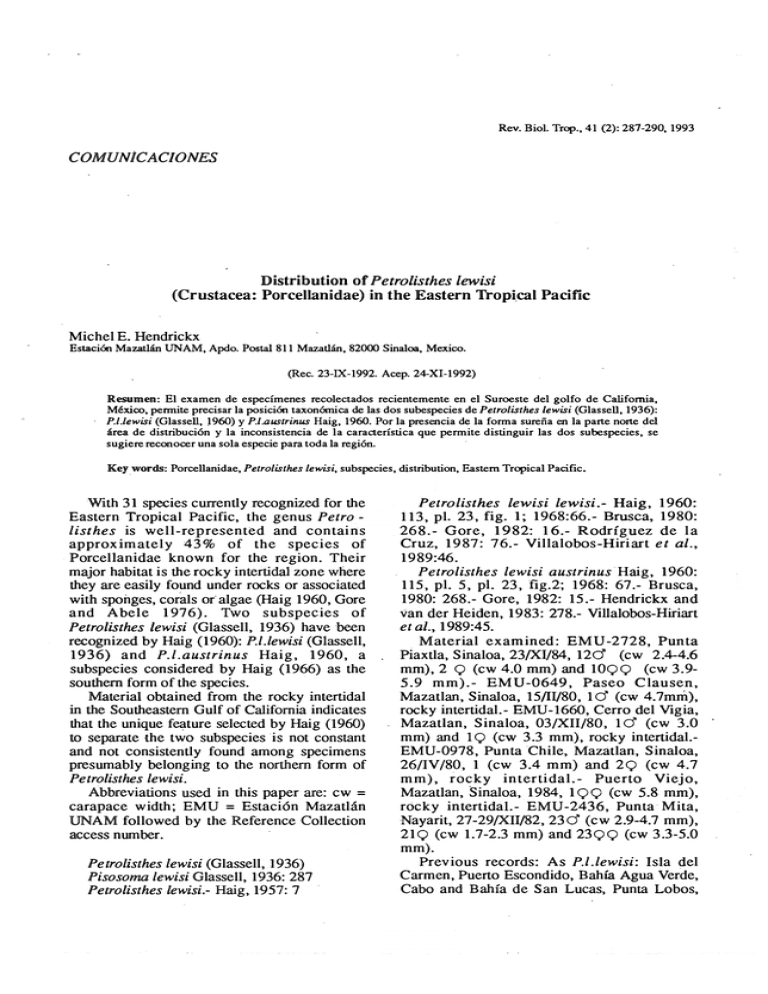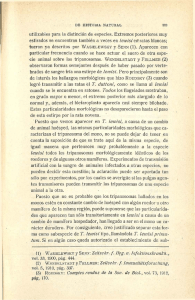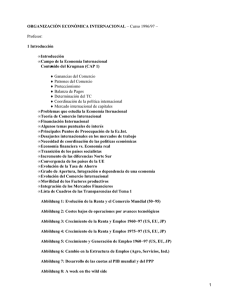(Crustacea: Porcellanidae) in the Eastern Tropical Pacific
Anuncio

Rev. Biol. Trop., 41 (2): 287-290,1993 COMUNICACIONES Distribution of Petrolisthes lewisi (Crustacea: Porcellanidae) in the Eastern Tropical Pacific Michel E. Hendrickx Estación Mazatlán UNAM, Apdo. Postal 811 Mazatlán,82000 Sinaloa, Mexico. (Rec. 23-IX-1992. Acep. 24-XI-1992) Resumen: El examen de especímenes recolectados recientemente en el Suroeste del golfo de California, México,permite precisar la posición taxonómica de las dos subespecies de Petrolisthes lewisi (Glassell, 1936): P.l.lewisi (GlasseU, 1960) y P.l .austrinus Haig, 1960. Por la presencia de la forma sureña en la parte norte del área de distribución y la inconsistencia de la característica que permite distinguir las dos subespecies, se sugiere reconocer una sola especie pa� toda la región. Key words: Porcellanidae, Petrolisthes lewisi,subspecies, distribution, Bastem Tropical Pacifico With 31 species currently recognized for the Eastern Tropical Pacific, the genus Petro.­ listh es is well-represented and contains approximately 43% of the species of Porcellanidae known for the region. Their major habitat is the rocky inteitidal zone where they are easi1y found under rocks or associated with sponges, coials or algae (Haig 1960,Gore and Abele 1976). Two subspecies of Petrolisthes lewisi (Glassell, 1936) have been recognized by Haig (1960): P.l.lewisi (Glassell, 1936) and P.l.austrinus Haig, 1960, a subspecies considered by Haig (1966) as the southern form of the species. Material obtained from the rocky intertidal in the Southeastern Gulf of California indicates that the unique feature selected by Haig (1960) lO separate the two subspecies is not constant and not consistently found among specimens presumably belonging to the northern form of Petrolisthes lewisi. Abbreviations used in this paper are: cw = carapace width; EMU = Estación Mazatlán UNAM followed by the Reference Collection access number. Petrolisthes lewisi lewisi.- Haig, 1960: 113, pI. 23, fig. 1; 1968:66.- Brusca, 1980: 268.- Gore, 1982: 16.- Rodríguez de l a Cruz, 1987: 76.- Villalobos-Hiriart e t al., 1989:46. Petrolisthes lewisi austrinus H aig, 1960: 115, pI. 5, pI. 23, fig.2; 1968: 67.- Brusca, 1980: 268.- Gore, 1982: 15.- Hendrickx and van der Heiden, 1983: 278.- Villalobos-Hiriart et al., 1989:45. Material examined: EMU-2728, Punta Piaxtla, Sinaloa, 23/X1/84, 12d (cw 2.4-4.6 mm),2 9 (cw 4.0 mm) and 1 099 (cw 3.95.9 mm).- E M U - 06 4 9 , Pas eo C lausen, Mazatlan, Sinaloa, 15/11/80, Id (cw 4.7JlUÍl), rocky intertidal.- EMU-l660, Cerro del Vigia, Mazatlan, Sinaloa, 03/XII/80, Id (cw 3.0 mm) and 19 (cw 3.3 mm), rocky intertidal.­ EMU-0978, Punta Chile, Mazatlan, Sinaloa, 26/1V/80, 1 (cw 3.4 mm) and 2 9 (cw 4.7 mm), r o c k y interti dal.- Puerto Viejo, Mazatlan, Sinaloa, 1984, 199 (cw 5.8 mm), rocky intertidal.- EMU-2436, Punta Mita, Nayarit, 27-29/XII/82,23d (cw 2.9-4.7 mm), 219 (cw 1.7-2.3 mm) and 2399 (cw 3.3-5.0 mm). Petrolisthes lewisi (Glassell, J 936) Pisosoma lewisi Glassell, 1936: 287 Petrolisthes lewisi.- Haig, 1957: 7 Prev ious records: As P.l.lewisi: Isla del Carmen, Puerto Escondido, Bahía Agua Verde, Cabo and Bahía de San Lucas, Punta Lobos, 288 REVISTA DE BIOLOGIA TROPICAL Baja California. Isla Isabel, Islas Tres Marias, Nayarit. Tenacatita (type locality), Jalisco; Bahía de Tequepa (Acapulco), Guerrero; aH locaHties in Mexico (Haig 1960). Zihuatanejo, Guerrero, Puerto Huatulco and Bahía Tangola­ Tangola, Oaxaca, Mexico (Haig 1968). Bahía Guastecomate, Jalisco, Mexico (Goce 1982). Islas Tibur6n, San M arcos, Montserrat ami Cerralvo, Gulf of California (Villalobos-Hiriart et al. 1989) (Hg.1). CITll1l1N Ll'IERATURB AS: . Jl. PEfROL!STl:lES LEWISI LEWIS¡ PETROLlSTIlES LEW!S! AUSl'RlNUS PRESEIIl' S'IUOY SAMPLIN LOCALITlllS " , . Hg. l. Distributioo oí Petrolisthes lewisi in me Bastem Tropical Pacifico As P.l.(Justrinus: Puerto P a rleer ( type locality, Bahía Elena, aoout 8 km north oí Punta Blanca) and Bahía Salinas, Costa Rica; Islas Flamenco, Taboga and Jicarita. Otoque, Islas Perlas. Guayabo Chiquito, Panama; B<lhfa de Cupica. Puerto Utria, Cabo C orrientes, Colombia; Cabo San Francisco, Manta. Punta Santa Elena, Ecuador (Haig 1960). Golfo de FOl1seca, Nicaragua, Bahía Honda, Panama (Haig 1968). Isla Culebra, Isla Perica, Panama ( G o re 1982 ) . M azatlan, Sinaioa, Mexico (Hendrickx and van der Heiden 1983). Islas Tiburón and Cerralvo (Villalobos-Hiriart et al. 1989) (Hg.l). Remarks: Specimel1s typical of Petf'olisthes iewisi austrinus sensu H a i g, 1960, were collected in Nayarit ana Southem Sinaloa; fuey all llave reeth 1-3 on anterior margil1 of carpus dearly separated, almost equal in size and triangular in shape (Fig. 2A). Other spedmens, from the srune area, present sHghtly reduced 1st and 3rd teeth (Hg. 2B, C), but all teeth are stiU weH-separated. Partly coalescent teeth are shown by other specimens (Fig. 2 D-G). In stiU anotner specimen, left chelae show almost completely coalescel1t 1st and 2nd teeth on left carpus while teeth 011 right carpus are well­ separated (Fig. 2 H). A fourth teeth on anterior margin of Cfu.-pUS appears in only oue specimen (Fig.2E). Accordíng to Haig (1960), me only feature Ilsed to separate subspecies of Petrolisthes lewisi is the degree of coalescence shown by carpal teeth: partía]. or complete fusion of me pmximal 2-3teeth 1S found in the northem form ruad define specimens of P.l.lewisi, while weH-separa!.ed teeth characterize the southern form, austrinus. Haig's data also indicate that subspecies distribuuon do not overlap. T he material examined herein oot o nly inrucates typical "southem formOl is found at l1orthemmost distributioo Hmit of the "l1orthem form", but also that an individual features a northem-like carpus on one cheliped and a southem-like carpus on fue other. 00 !he basis of these new dat.a, it is suggested !hat subspecies of Petrolisthes lewisi should n o longer b e recognized a n d that the range o f Glassell'species snould be considered without a break fíOm Isla San Marcos (27015'N), east side of the Gulf of California, and Punta Piaxtla (23039'N), west side of !he Gulf of California, Mexko, to Punta Santa Elena (2°lO'S), Ecuador. HENDRICKX: Distribution eX P,trolisthes l,wisi 289 Fig. 2. Dorsal view of chelipeds of Petrolisthes l,wisi (GlasseR, 1936). A-O, specimens fran Punta Mita, Nayarit, M�co; E­ H. specirnens from Mazadan, Sinaloa. REVISTA DE BIOLOGIA TROPICAL 290 The auth o r thanks Janet Raig, ABan Rancock Foundation, Los Angeles, for exarnining sorne of tlle specirnens reponed h erein and Graciano Valenzuela for me original 3rt work. REFERENCES B rusca. R.C. 1980. Cornrnon Intertidal Invertebrates of the Gulf of California. 2nd. &l. University of Arizona Press, Tucsoo, Arizona.513p. Glassell. S.A. 1936. New porcellanids an d pinnolherids from tropical North American waters. Trans. San Diego Soco Nat. Hist. 8(14):91-Hl6. Gore, R. H. 1982. Porcellanid craoo fmm !he roast oí Mexico and Central Arnericll (Crustacea, Decapo da, Anomura). Srnith. Contrib. Zool. 363:1-32. Haig, J. 1960. The Porcellanidae (Crustacea Anomura) oí Ihe Eastern Pacifico Allan Hanoock Pacific Exped. 24:1-400. Haig, J. 1968. Eastem P acific Expedi.tions of!he New York Zoological Society. 47. Porcellanid crabs (Crustacea: Anomura) frorn the west coast of tropical Arnerica. Zoologica.53(2):57-74. Hendricla M.E. & A.M. van dee Heiden. 1983. New record! of twelve species of crustaceans along !he Pacific roast of Mexico. Aa InsL Ciene. del Mar y Lirnnol., Univ. Nal. Amón. México. 10(1):277-279. R o dríguez de la Cruz, M.C. 1987 . Crustáceos decápodos del Golfo de California. Sría. de Pesca (Ed.), México, D.F. 306 p. Villalobos, J.L. J.C. Nates Rodríguez, A. CantIÍ Díaz B arriga. M.D. Valle Martínez, P. Flores Hemández, E. Lira Femández & P. Schmidtsdorf Valencia. 1989. Listados faunísticos de México. I. Crustáceos estomatópodos y decáp o dos intermareales de l as islas del G o lfo de California, México. Pub!. Esp. An. InsL Siol., UNAM.


